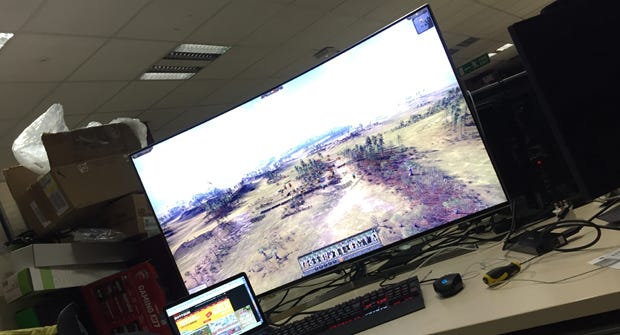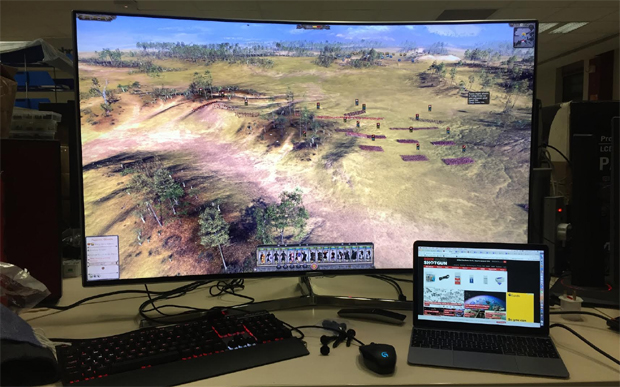Are the latest UHD TVs any good for PC gaming?
Dirty job, but somebody had to do it
Occasionally, it falls upon me to make solemn sacrifices in the name of empirical endeavour, the advancement of science and the betterment of mankind. It is very much in this altruistic spirit that I recently embarked upon an exhaustive and forensic investigation into the merits of the latest UHD / 4K / HDR TVs as PC monitors. Yes, I’ve been playing games on TVs. This is what I learned.
Broadly speaking, I subscribe to the notion that big screens are fun. TVs are big screens. Therefore using a TV as a PC gaming screen is a bit of a no brainer, right? Would that it were so.
In reality, TVs have historically represented a flawed proposition as gaming monitors. What they gave in sheer scale they often took away in resolution, accuracy, response or practicality. But TV technology has changed out of all recognition of late, especially in the last 12 months.
TVs now routinely offer native resolutions to match or better most PC monitors. There are no overwhelming interface issues. And in many ways their primary panel tech is superior - on paper, at least. It’s time to revisit the TV as PC gaming device.
Back in ye olden times, hooking up your PC to a TV via S-video was fun for about five seconds. Once the novelty of seeing your favourite games on a very large goldfish bowl (28 inches, gasp, etc) wore off, the ghastliness of the blurry, compressed image quality was all too obvious.
Then the LCD revolution happened, digital interfaces became the norm and you could at least drive an HDTV with a clean, digital signal. But even back when 1080p seemed exotic, stretching out 1,920 by 1,080 pixels over, say, a 40-inch panel made for ugly, chunky pixels.
What’s more, crap colour accuracy, awful input lag and obvious image compression were often in the mix. Superficially big and beautiful but fundamentally borked was pretty much what you got.
 My funky 40-inch Philips next to my puny old 30-inch Samsung...
My funky 40-inch Philips next to my puny old 30-inch Samsung...
As I’ve learned, that’s no longer the case. As it happens, for a couple of years my primary production PC has been running what is really a UHD TV in disguise. It’s a Philips BDM4065UC, which is a 40-inch 4K panel that’s really designed for TVs, but with some PC-friendly electronics including DisplayPort. It’s flawed, but I love it.
However, my main muse for this particular ruse is a Samsung UE49KS9000 9 series beast. With quantum dots, HDR support, 4K native and a curved panel it’s pretty close to, if not quite at, the very cutting edge of current LCD TV tech (OLED is another bag of subpixels).
Anyway, initial impressions reveal that it’s painless right out of the box. There are no issues driving it at 4K and 60Hz over HDMI 2.0 via an Nvidia Pascal GPU, in this case a GeForce GTX 1080. It’s likewise immediately obvious that the screen’s basic calibration is more than merely acceptable, it’s good.
The colour balance is pretty much in line with a PC monitor, there’s no silly over saturation, no hideous compression in gradients and, perhaps the biggest worry, no discernible input lag.
And then there’s the sheer giddy scale of the thing. I’m used to 4K. But this thing is spectacular, it’s genuinely exciting even for a dessicated seen-it-all-before hack like me. It makes you really want to play games. It makes you excited about playing games. This, I think, counts for something.
There’s also bona fide utility. The combination of scale with a big pixel count is fantastic in strategy games like Total War. At one and the same time, you can observe the action in fairly close detail while also maintaining a pretty broad overview of the battlefield. And all the while with oodles of space for menus and tools. It lends a heightened sense of all-seeing omnipotence to proceedings, which is the point of this kind of game, after all.
What’s more, as good as all this sounds, it could have been even better. This TV is HDR capable, but I wasn’t driving it with HDR content.
Anyway, 50-inch gaming at 4K is spectacular for pretty much any genre. And yet that’s not to say it actually makes sense. For starters, you still have to make sacrifices. As things stand, you can’t have 120Hz-plus refresh or adaptive frame syncing with this type of screen, for instance.
But it’s really the PC’s multi-purpose remit where the proposition stumbles. Over the years, I’ve been more tolerant than most in regards really big screens in practical terms. I remember how frequently people used to dismiss 30-inch monitors as simply too large for the desktop. That seems quaint, now.
But 50 inches and beyond? Even with the benefits of a curved panel, there are undoubtedly ergonomic issues when sitting in front of a screen this big when situated at monitor-ish distances. Most obviously, an awful lot of head movement is implicit - eye swiveling doesn’t get the job done, not even close. That’s exacerbated by the fact that TVs usually sit on static stands, though various mounts and arms can be used to optimise your setup, at a cost.
Then there’s the fact that with anything much beyond 40 inches, the pixel pitch is becoming a little coarse for desktop work even with a 4K native resolution. It’s the same old problem - what’s the point of a bigger screen in productivity terms if it doesn’t bring any extra pixels?
While 6K or 8K would solve that problem, it would exacerbate another, which is driving the bloody thing smoothly in games, a hard enough task for even the latest graphics cards at 4K. I should also point out that your mileage may vary when it comes to metrics like input lag with these things. I certainly wouldn’t assume any given TV didn’t suffer from input lag, that’s for sure.
 This is when it stops making sense...
This is when it stops making sense...
All of which means that a good UHD TV is a fabulous gaming device, but not a great PC monitor. And that makes me a little uncomfortable. Anything that bifurcates the PC makes me uncomfortable, in fact. It’s the PC’s multi-tasking prowess that for me makes it such a compelling platform. But a PC running through a UHD TV is really only optimal for games and even then not without its shortcomings.
TL;DR
- The latest UHD / HDR / 4K sets are the best TVs yet for PC gaming
- But they’re still not suitable for multi-purpose computing










